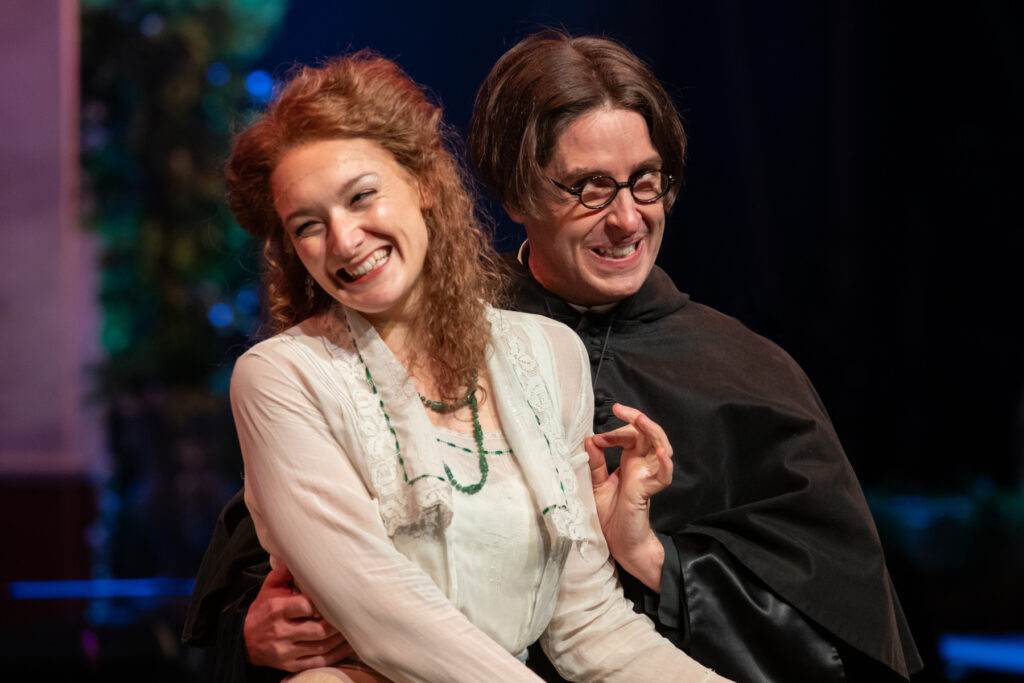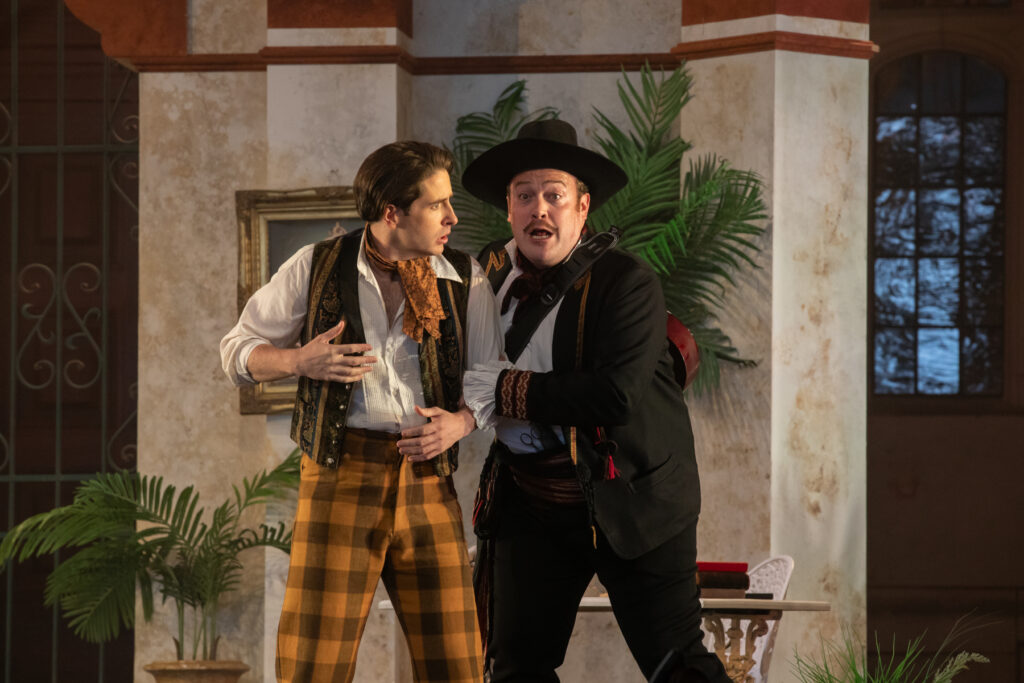Ingénues might be forgiven for wondering why Rossini’s opera The Barber of Seville isn’t named after the romantic hero who fights tooth and nail to win the object of his love, the beautiful Rosina who is Dr Bartolo’s ward. Dashing and intrepid heroes are after all the stuff of romantic literature, and indeed all art. But no, it’s not Count Almaviva, it’s Figaro. On reflection this is no great surprise: in modern parlance Figaro is an influencer par excellence. He enables, he facilitates, he fixes; Seville’s factotum is the ultimate wingman, an all-round man of action.
Creating a worthy performing space in any open-air setting is always a challenge. Director Cecilia Stinton’s solution for Opera Holland Park, working with designer Neil Irish, is a series of Moorish-inspired pillars and arches stretching across the back of the stage, with wrought-iron gates on either side, and walkways leading down to an additional area in front of the orchestra. This serves as a café with a central fountain. It is replaced for Act 2 by the interior of Dr Bartolo’s house, replete with wickerwork furniture in the colonial style. The full Spanish flavour of Seville as such is only hinted at, with superimposed effects proving to be something of a distraction. Thus, a portrait of an aged Queen Victoria appears on a back wall as a period nod to afternoon tea, graced by a bowler-hatted English waiter wearing white gloves and carrying a cake-stand, only for Don Basilio to appear later in Act 1 with a portrait of a Madonna as a replacement for the British sovereign.

The production itself is quite busy, including entrances and exits from different parts of the auditorium. This busyness is apparent even before the start of the overture: Don Basilio lies down in the empty fountain; some exhausted waiting staff in the café recover from a long night of drinking and carousing, while others collect bottles and glasses, and two more juggle a box of oranges. Once past the overture, there is an excess of activity on stage. Comings and goings include the English waiter with an armband displaying the Union Flag and gesticulating on a map, a flower-seller with a tray of roses, an artist carrying an easel and empty birdcage, a guitar soloist and soldiers doubling up as musicians. Much is done to reinforce the character of an opera buffo, so that at one point Figaro offers the conductor a shave, and much later in Act 2 she and Almaviva, disguised as the singing-teacher Don Alonso, exchange roles as harpsichord player and conductor. Lots of details indicate that attention has been paid to sharp characterisation. Thus Berta, sometimes seen as a governess for Rosina but here more obviously a housekeeper, smokes a cigarillo and is clearly partial to alcohol. At the very end Rosina throws her bridal bouquet over her shoulder in Berta’s direction; the old maid is destined to capitulate to love too. Bartolo is presented as a doctor of archaeology surrounded by learned volumes in Act 2, with more of an affectionate attachment to an amphora than to his ward and intended bride. His appearance, however, kitted out for the tropics and with streaks of red in his face indicating extreme sunburn, together with a butterfly net, suggests not a southern man of medicine but an intrepid colonial explorer from much farther north.
There is a lack of coherence in the costumes. Almaviva wears designer-style checked trousers on his first appearance; by the time his true identity has been resolved in Act 2, he is dressed in a 3-piece beige suit complete with watch-chain. Figaro’s garb makes him look almost like a toreador; at one stage Bartolo sports a fez. Overall there is a preponderance of warm brown tones, creams and whites. The lighting remains unobtrusive and unimaginative until the thunderstorm episode in Act 2 where Robert Price pulls out all the stops expertly.
If this Il Barbiere, last staged by Opera Holland Park ten years ago, disappoints on a number of counts, the singing is more than satisfactory. Paul Grant as Figaro is a commanding presence with authority in his voice. You just know he can will anybody to do anything. His warm and rounded baritone was displayed to great effect in his major aria of Act 1, the ‘Largo al factotum della città’, with an exhilarating accelerando towards its close. In the many recitatives with plenty of patter he sustains continuing interest in the developing characterisation. Heather Lowe’s Rosina is a sheer delight. She plays her as a feisty individual determined to escape the shackles of her existence. This caged bird will fly, she seems to be saying. She eases her way through the tessitura, excelling in the florid ornamentation during her Act 2 singing-lesson, all the elements of her coloratura gleaming and glistening. Just as impressive is her Act 1 cavatina ‘Una voce poco far’, in which the smoky tones of her deeper chest register reinforce the viper-like menace in the voice. She is, as Bartolo says of her, a little minx, knowing exactly when to bare her teeth. One other character won me over: the dark-chocolate richness of Jihoon Kim’s bass as Don Basilio, oozing through every pore the slightly disreputable and oleaginous reputation he has already garnered. I will treasure his cavernous Act 2 ‘buona sera’ for some time to come.

Bartolo’s visual presentation continued to bother me during the entire opera. Stephen Gadd sings the role with complete assurance, but I failed to detect any erotic charge coming from him towards Rosina. Indeed, I found his academic preoccupations just as unsettling as the moments of cruelty, evident in the way he takes Rosina’s sketch of Almaviva and tears it in half. Actions speak louder than words. Elgan Llŷr Thomas’s steel-edged Almaviva took some time to settle. In Act 1 there were moments of strain, an absence of smoothness in transition, but this gave way to much greater mellifluousness in his later guises as Lindoro and Don Alonso. What stood out for me, however, was his range of comic talents as Rosina’s singing-teacher. His grimaces spoke volumes.
All the minor parts were well taken and the sixteen-man chorus sang lustily. The ensemble pieces at the end of the two acts were quite delicious. Charlotte Corderoy, directing the City of London Sinfonia in the pit, kept the orchestral textures light and fluffy, allowing the potent mixture in the pot to come effectively to the boil in some splendidly graduated Rossinian crescendos, and always giving attentive support to her singers. She has a busy summer ahead of her, directing another production of Il Barbiere in August at the Waterperry Opera Festival.
So what’s left at the end of this comic opera? Is it all just a cup of frothy cappuccino or a glass of sparkling spumante? If opera has meaning in the modern world – and the many productions of this work together with the enthusiastic audiences who flock to them are testament to that – it is because the plot of Il Barbiere has the power to connect with us individually, and on many different levels. Though Rosina successfully outmanoeuvres her supposed protector, what lies behind it all is a dark and disturbing example of coercive control. In fiction I was reminded of John Fowles’s powerful novel The Collector and in the real world of the numerous cases in recent times where young women have been deprived of their liberty by obsessive males. Opera connects. It is entertainment but it also opens our minds to the darker sides of human existence.
Performances continue until 21 June.
Alexander Hall
The Barber of Seville
Music composed by Gioachino Rossini
Libretto by Cesare Sterbini based on Pierre-Augustin Caron de Beaumarchais’s comedy Le Barbier de Séville ou la Précaution inutile
Cast and production staff:
Count Almaviva – Elgan Llŷr Thomas; Doctor Bartolo – Stephen Gadd; Rosina – Heather Lowe; Figaro – Paul Grant; Don Basilio – Jihoon Kim; Berta – Janis Kelly; Fiorello – Jack Holton; Ambrogio – Dragoş Andrei Ionel; Officer – Robert Garland.
Director – Cecilia Stinton; Designer – Neil Irish; Lighting Designer – Robert Price; Movement Director – Bence Kalo; Chorus Master – Dominic Ellis-Peckham; City of London Sinfonia; Conductor – Charlotte Corderoy.
Opera Holland Park, London, 4 June 2024
All photos by Ali Wright courtesy of Opera Holland Park.